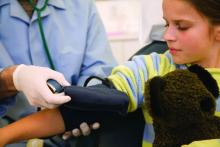Twenty-three percent of children with hypertension and 10% of those with prehypertension were diagnosed by clinicians, based on data from a retrospective study of more than 398,000 children in the United States.
In addition, only 6% of children who met criteria for hypertension received treatment within a year of their diagnosis.
“Lack of diagnosis prevents the initiation of guideline-based treatments, including lifestyle modification and medication,” wrote David C. Kaelber, MD, of Case Western Reserve University, Cleveland, and his colleagues (Pediatrics 2016 Nov 22;138:e20162195. doi: 10.1542/peds.2016-2195).The researchers reviewed data from 398,079 children and adolescents aged 3-18 years who were part of the Comparative Effectiveness Research Through Collaborative Electronic Reporting Consortium. The patients had at least three visits with blood pressure and height measured.
The final study population included 12,138 children with hypertension at 44 sites and 38,874 children with prehypertension at 77 sites. Of the children with hypertension, 23% had hypertension or abnormal blood pressure diagnosis in their electronic health record (EHR). In addition, 32% of 4,996 children with stage 2 hypertension had an EHR diagnosis. A diagnosis was more likely in children who were male, taller, older, heavier, had at least one blood pressure measurement in the stage 2 range, or who had additional measurements beyond the three needed for a diagnosis.
Of the children with prehypertension, 10% had a diagnosis of hypertension or abnormal blood pressure in their EHRs. Diagnosis was more common among males and those who were older, heavier, taller, had more than one blood pressure measurement in the stage 2 range or had additional readings beyond those needed for diagnosis, the investigators said.
Of 2,813 pediatric patients who met criteria for hypertension and continued to have high blood pressure readings, only 6% were prescribed medication within 12 months of diagnosis. The average age for medication initiation was almost 14 years, and the most commonly prescribed medications were angiotensin-converting-enzyme inhibitors or angiotensin-II-receptor blockers for 35% of children, diuretics for 22%, calcium channel blockers for 17%, and beta blockers for 10%, Dr. Kaelber and his associates reported.
The study results were limited by several factors, among them the reliance on ICD-9 codes for identification of abnormal blood pressure and inclusion of all reasons (preventive care and nonpreventive care) for visits to primary care pediatric providers. The findings, however, suggest that “intervention is needed to help pediatric primary care clinicians recognize and treat hypertension and prehypertension,” they wrote.
Funding was provided by U.S. Department of Health & Human Services grants and by the Eunice Kennedy Shriver National Institute of Child Health and Human Development. The researchers had no relevant financial disclosures.


